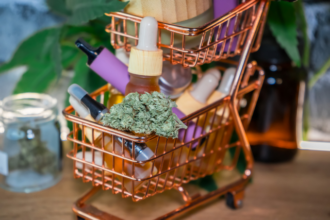THC candies offer a fun and tasty way to consume cannabis. These edibles come in various flavors and forms, such as gummies, chocolates, and mints. They provide an alternative to smoking and can deliver a more controlled and longer-lasting effect.
As people explore the world of cannabis, many are drawn to the sweetness of THC candies. These treats often have an appealing taste, making them a popular choice among both new and experienced users. They can also come in balanced ratios of THC and CBD, catering to different preferences and needs.
Understanding how to consume THC candies safely is essential. Experts recommend starting with a low dose and waiting to see how it affects them before taking more. This approach helps prevent consuming too much, especially since the effects can take time to kick in.
What Are THC Candies?
THC candies are edible treats infused with tetrahydrocannabinol (THC), the main psychoactive compound in cannabis. These candies provide an alternative way to consume cannabis, appealing to both new users and seasoned consumers due to their convenience and flavor.
Composition and Types
THC candies can contain varying amounts of THC, typically ranging from 5 to 10 milligrams per piece. The exact dosage is often specified on the packaging, making it easier for consumers to manage their intake.
These candies come in several forms, including:
- Gummies: Soft, chewy candies available in various shapes and flavors.
- Hard Candies: Sugar-based candies with a long shelf life.
- Chocolate: THC-infused chocolate bars that offer a rich taste.
Some products also include CBD along with THC, providing potential therapeutic effects without intense psychoactivity. Consumers should always check labels for exact THC and CBD levels to ensure safe consumption.
Usage Trends
The popularity of THC candies has increased significantly. Many cannabis users prefer these treats over traditional smoking methods due to their discreet nature and enjoyable flavors.
In 2022, sales projections for THC candies soared, reaching approximately $2.2 billion. This growth shows that consumers are leaning toward sweet, flavorful options that fit easily into their lifestyles.
Additionally, the variety of flavors and forms available caters to different preferences, making these candies a versatile choice in the cannabis market. Users are encouraged to be aware of dosage, as effects can take longer to set in compared to smoking.
Health and Legal Implications
THC candies have gained popularity, but they come with important health risks and complex legal issues. Understanding these factors is crucial for consumers and policymakers alike.
Health Considerations
THC candies can lead to various health effects. One concern is the potential for overconsumption. Many cannabis edibles, including candies, are potent, and users might not realize how much THC they are consuming.
Ingesting high doses can result in intense reactions, such as anxiety and paranoia. Gastrointestinal issues are also linked to cannabis use, with different reactions reported for smoking versus eating edibles. Edible products can take time to kick in, which may lead users to consume more than intended.
Additionally, there are risks associated with driving under the influence of THC. Studies show that the percentage of fatal accidents involving cannabis doubled between 2000 and 2018. It’s vital for users to be aware of how these products impact their ability to drive safely.
Legal Status
The legal status of THC candies varies by region. In the United States, cannabis is classified as a Schedule I substance. However, many states have legalized cannabis for medical and recreational use. As of 2021, 36 states and Washington D.C. have legalized some form of cannabis.
Despite this, there are still restrictions on the sale and distribution of THC candies. Many states regulate the packaging and labeling of edibles to prevent accidental consumption by children.
Understanding local laws is essential for consumers. Possessing or distributing THC candies may have different legal consequences depending on the jurisdiction. Always check local regulations to ensure compliance.
Manufacturing Processes
The manufacturing of THC candies involves careful selection of ingredients and strict quality control measures to ensure a safe and enjoyable product. The processes combine culinary skills with precise measurements and adherence to regulations.
Ingredients and Preparation
Key ingredients for THC candies include sugar, flavoring agents, and cannabis extracts. The primary source of cannabis in these products is often THC oil or distillate. Manufacturers must select high-quality cannabis to ensure potency and flavor.
During preparation, sugar is heated to create a syrup. This syrup is then mixed with other ingredients, including flavorings and colors. The cannabis extract is carefully incorporated, ensuring an even distribution throughout the candy. Attention to temperature and timing is crucial for achieving the desired texture and taste.
Typical Ingredients:
- Sugar
- Water
- Flavoring agents
- Cannabis extract
- Colorants (optional)
Proper mixing and cooking techniques lead to the final candies’ consistent quality and flavor.
Quality Control
Quality control is vital in the production of THC candies. Manufacturers must adhere to strict regulations to ensure safety and labeling accuracy. This involves regular testing of both raw materials and final products.
Testing includes checking for THC content to ensure compliance with legal limits. Manufacturers may also test for contaminants such as pesticides or solvents. Documentation of each batch is essential for traceability.
Quality Control Steps:
- Testing of raw materials
- In-process checks during manufacturing
- Final product testing for potency and purity
By implementing these quality control measures, manufacturers can guarantee a safe and reliable product for consumers.
Consumer Information
Knowing how to read labels and follow safe consumption practices is crucial when dealing with THC candies. This information helps consumers make informed choices and avoid potential hazards associated with these products.
Labeling and Packaging
THC candies must have clear and accurate labeling. This includes information about the amount of Delta-8 or Delta-9 THC per serving. Consumers should look for a THC content chart on the package.
It’s important to check for any warnings about effects, especially regarding potential risks for children. The packaging should not resemble popular children’s snacks or candies. Distinct packaging reduces the chance of accidental ingestion.
Here are some key points to check on the label:
- Ingredients list
- THC dosage per piece
- Warning symbols for child safety
Consumers should avoid products with misleading packaging that could be confused with regular snacks.
Safe Consumption Practices
To consume THC candies safely, individuals should start with a small dose. This measure helps them gauge their tolerance. It is common for these candies to take time to show effects, typically between 30 minutes to 2 hours.
It is advisable to keep these products out of reach of children to prevent accidental ingestion. A locked cabinet or high shelf is recommended for storage.
Always read the dosage instructions on the package. If uncertain, consult with a knowledgeable seller or a healthcare professional.
Here are some recommended practices:
- Start low, go slow
- Store safely
- Avoid combining with alcohol or other substances
These practices can help ensure a safer experience with THC candies.


 Trending:
Trending:











